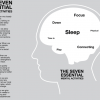So you've become somewhat dependent and use it as a bit of a crutch. Are you to say had you never used it, you would now be unemployed and homeless? I find it hard to believe amphetamines are the only thing which would able to function.
While someone taking 60mg daily may not technically be abusing adderall, they will start to feel the effects of damage, and cross over into the toxic regime.
Persistent Structural Modifications in Nucleus Accumbens and Prefrontal Cortex Neurons Produced by Previous Experience with Amphetamine
Experience-dependent changes in behavior are thought to involve structural modifications in the nervous system, especially alterations in patterns of synaptic connectivity. Repeated experience with drugs of abuse can result in very long-lasting changes in behavior, including a persistent hypersensitivity (sensitization) to their psychomotor activating and rewarding effects. It was hypothesized, therefore, that repeated treatment with the psychomotor stimulant drug amphetamine, which produces robust sensitization, would produce structural adaptations in brain regions that mediate its psychomotor activating and rewarding effects. Consistent with this hypothesis, it was found that amphetamine treatment altered the morphology of neurons in the nucleus accumbens and prefrontal cortex. Exposure to amphetamine produced a long-lasting (>1 month) increase in the length of dendrites, in the density of dendritic spines, and in the number of branched spines on the major output cells of the nucleus accumbens, the medium spiny neurons, as indicated by analysis of Golgi-stained material. Amphetamine treatment produced similar effects on the apical (but not basilar) dendrites of layer III pyramidal neurons in the prefrontal cortex. The ability of amphetamine to alter patterns of synaptic connectivity in these structures may contribute to some of the long-term behavioral consequences of repeated amphetamine use, including amphetamine psychosis and addiction.Can a therapeutic dose of amphetamine during pre-adolescence modify the pattern of synaptic organization in the brain?
This treatment produced an increase in dendritic length and branches of pyramidal neurons of the medial prefrontal cortex, but not in the nucleus accumbens. These changes were associated with an increase in the expression of calcium/calmodulin-dependent protein kinase II, a highly abundant signalling protein in the postsynaptic densities of excitatory synapses. Interestingly, amphetamine pre-treatment did not alter the motor response to various dopamine agonists, including amphetamine. These data suggest that clinical doses of stimulant drugs may be acting as a trophic support at the glutamatergic synapses, thereby enhancing dopamine-glutamate interactions in the prefrontal cortex.
Heat shock protects cultured neurons from glutamate toxicity
http://www.sciencedi...896627391903484
NMDA receptor-mediated glutamate toxicity of cultured cerebellar, cortical and mesencephalic neurons: neuroprotective properties of amantadine and memantine
http://www.sciencedi...00689939390464XExcitotoxic lesions of the pedunculopontine differentially mediate morphine- and d-amphetamine-evoked striatal dopamine efflux and behaviors.
http://www.ncbi.nlm....pubmed/11983320
A Mechanism for Amphetamine-Induced Dopamine Overload
http://www.ncbi.nlm....cles/PMC368179/
Dopamine-induced changes in neural network patterns supporting aversive conditioning.
http://www.ncbi.nlm....pubmed/19961836Altered pattern of brain dopamine synthesis in male adolescents with attention deficit hyperactivity disorder
http://www.ncbi.nlm....les/PMC1698925/See: ginkgo[1], ginseng[1], [2], green tea[1], [2], [3], [4], [5]
Dopamine Uptake Inhibitors but Not Dopamine Releasers Induce Greater Increases in Motor Behavior and Extracellular Dopamine in Adolescent Rats Than in Adult Male Rats
http://www.ncbi.nlm....les/PMC2957786/Altered dopaminergic innervation and amphetamine response in adult Otx2 conditional mutant mice.
http://www.ncbi.nlm....pubmed/16256364
and you don't know what you may come down with later in life, say parkinsons, then even therapeutic doses of amphetamine might be regrettable
Chronic Amphetamine Use and Abuse
Neurotoxic Effects of Stimulant Drugs
Sustained high-dose administration of amphetamines (especially methamphetamine) to experimental animals produces a persistent depletion of DA which is associated with terminal degeneration (62, 182, 195), as well as neuronal chromatolysis in the brain stem, cortex and striatum (42, 182). In contrast, continuous dosing with extremely high doses of cocaine (100–250 mg/kg/day i.v.) did not induce terminal degeneration in frontal cortex and striatum (62, 183). Recently, Cubellis et al. (36) presented evidence that amphetamine, in contrast to cocaine, induces redistribution of DA from the vesicles into the cytosol; thus, the loss of the protection of the vesicles' relatively reducing environment results in cytosolic oxidative stress that may initiate amphetamine neurotoxicity. The DA depletion is reported to be permanent in the caudate of monkeys (196). The main hypotheses for underlying mechanisms have included 1) the conversion of DA into a hydroxy oxidative metabolite (195, 196); and 2) glutaminergic stimulation of toxicity, which can be inhibited by N-methyl-D-aspartate antagonist MK-801 (200).
Methamphetamine toxicity is inhibited by a variety of drug treatments, including: 1) DA synthesis inhibitor alpha-methyl-para-tyrosine; 2) DA receptor antagonists; 3) NMDA receptor antagonists, e.g., MK-801; 4) DA and serotonergic reuptake inhibitors protecting against DA and serotonin toxicity respectively (195). Even though most studies have found that serotonergic and DA reuptake inhibitors specifically protect these two sites, certain reuptake blockers (such as benztropine) do not (195). On the other hand, mazindol, a non-specific blocker, protects against both DA and serotonergic neurotoxicity. Ali et al. (1994) have further demonstrated in mice that a major factor for neurotoxicity is hyperthermia which is highly correlated with the degree of long-term DA depletion (21). Furthermore, haloperidol, diazepam and MK-801, all of which can reduce methamphetamine-induced hyperthermia, protect rats against DA depletion (4). They also demonstrated that reducing the ambient temperature (4°C) reduced neurotoxicity to the same levels found when phenobarbital, diazepam and MK-801 were present to protect the cell. Tolerance to methamphetamine induced by increasing doses also reduces the hyperthermic response and as well protects against neurotoxicity (89, 188).
An important caveat is that not all protective mechanisms act by preventing the hyperthermic effect; the monoamine uptake blockers inhibit neurotoxicity in the absence of inhibition of hyperthermia, e.g., fluoxetine blocks methamphetamine serotonin toxicity without reducing temperature (140). The monoamine protection from neurotoxicity by reuptake inhibition is emphasized by the unexpected discovery that even massive and 24-hour continuous dosing of cocaine, e.g., 100 mg/kg/day, does not result in DA system neurotoxicity (119, 182, 183). Hyperthermia has been well documented to increase amphetamine stereotypy (93, 220). Hyperthermia alone is well known to result in neuronal chromatolysis and has been previously proposed as a significant contributor to amphetamine-induced DA depletion and neuronal damage in clinical as well as experimental animal histopathology (52). Hyperthermia may have been one of the factors resulting in deaths among athletes taking moderate doses of amphetamine in the 1960s and 70s (145). Even in mild hyperthermia, increased body temperature induces a linear decrease in the inhibitory feedback of stimulants on somatodendritic autoreceptors (130). Thus, body temperature changes induced by amphetamine should be considered as one of the contributors to toxicity.
One of the hallmarks of amphetamine-induced neurotoxicity is the loss of DA uptake sites in the striatum and accumbens. These studies of transporters after chronic amphetamine have reported decreases in the range of 30–40% (158). Recently, Silvia et al. (198) addressed the functional significance of changes in transporters on amphetamine's behavioral effects. After seven days of infusion of transporter RNA antisense ODN into the SN/VTA nuclei, mazindol binding was reduced 32% in the caudate. Administration of 2 mg/kg of amphetamine at this time resulted in robust contralateral turning (an increase of 400%); in contrast, 10 mg/kg of cocaine induced no changes in the turning response. The lack of turning response to cocaine after transporter reduction contrasts with the substantial cocaine-induced contralateral turning after unilateral SN/VTA D2 ODN to reduce D2 autoreceptors in the striatum (199). Thus, the amphetamine-induced loss of DA uptake sites could have two consequences: 1) a protective mechanism reducing further neurotoxicity, and 2) reverse tolerance to subsequent amphetamine administration, perhaps resulting in adverse symptoms such as paranoid psychosis (see also the discussion on neurotoxicity in the habenular interpeduncular track and its possible relationship to augmentation amphetamine-induced adverse effects).
Recently, Fleckenstein et al. (68) reported that methamphetamine induced a dose-response sensitive reduction in [3H] DA uptake in washed striated synaptosomes which lasted for at least three hours; at 24 hrs the response had returned to normal. Since the decrease in intake was at maximum as early as 30 minutes after methamphetamine, this decrease in DA uptake is probably augmenting the amphetamine behavioral response and certainly not inducing tolerance. The decrease in DA uptake at doses up to 15 mg/kg could also provide some protection from neurotoxicity due to oxidative species.
These marked neurotoxic effects on the DA systems may underlie the mild Parkinson-like symptoms or "burned out" clinical picture in chronic, high-dose amphetamine abusers. These same individuals have a readily activated stimulant psychosis response. Similar re-activation of psychosis by L-dopa and direct agonists in Parkinson patients raises the question of whether the more severe psychosis resulting from amphetamine vs. cocaine abuse may have a partial basis in the greater toxicity induced by amphetamine.




















































